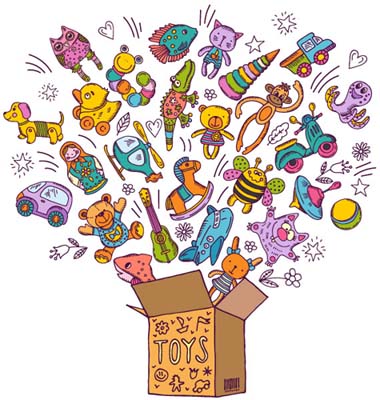Toy clutter, it’s a problem all parents face. From the toddler years when blocks, push toys, and board books seem to be scattered down the hallway to the school-age years where kids collect tiny
LEGOs, matchbox cars, and Barbie dolls, clutter remains an ongoing issue. Toy rotation is one way to fight this problem.

Step 1: Gather
In the main play area, gather all the toys to the centre of the room. You are making a bigger mess at first, but this will help you get organised in the long run. “It may be best to start this process when the kids are in bed or out of the house,” says mum Kara Thomas. The process may go quicker and smoother sans children. However, if that isn’t an option, get the kids involved and have them help bring toys to the centre of the room.
Step 2: Reduce
Go through the pile you have gathered and throw away broken toys and items that have missing pieces. Take out any toys that are no longer age appropriate. Lastly, pick out toys that the children don’t play with. This is a good annual practice as it helps keep the toy piles under control and can provide a little cash boost. If your family is not up for the work that goes into selling items, consider donating them to a local charity or passing them along to a friend.
Step 3: Sort
Once you have reduced the number of toys, you should be left with age-appropriate toys that your children enjoy. Now divide toys into three categories: thinking toys (puzzles, board games, shape sorters), pretend play (play food, dolls, blocks), and toys that encourage gross motor play (balls, push toys, cars). When you have the items sorted, there should be three piles, one for each category.
Step 4: Divide
Divide toys into three to four groups. Each group should have equal amounts of toys from the categories of thinking toys, pretend play, and gross motor toys. Place each group of toys into a large box and label it. Plastic tubs work well and can double as a toy box.
Step 5: Store
Once the toys are sorted and separated into three to four boxes, keep one out and put the remaining boxes in storage. Make sure you have easy access to the stored boxes so you can rotate them frequently.
Step 6: Rotate
Decide how long to keep a box out for play. Some families switch weekly, while some switch every two to three weeks and some may switch every month or longer. Choose a timespan that works for your family. When each box is out, take note of what toys are most popular and which items get ignored. As you are packing up the box, remove the items that didn’t get played with and donate or sell them.
Reducing Toy Clutter
- Participate in boot sales or consignment sales
- Pass them along to a friend or a family in need
- Donate to Tayf (qcharity.org) or check local Facebook groups for groups who organise donations to other countries
- Give them to a nursery or a preschool
- Take them to grandma’s house so the kids will have something to play with when they visit
- Try the Konmari Method using the book The Life-Changing Magic of Tidying Up: The Japanese Art of Decluttering and Organizing. If it doesn’t bring you or your kids joy, get rid of it.
- Throw out the junk. Get rid of cheap toys from fast food kid’s meals and festivals.
By implementing a toy rotation system, you will be able to cut down on toy clutter in your living space because three-fourths of the toys will be in storage at any given time. In addition to a tidier home, there will also be less mess for kids to clean up and a better chance for all toys to be utilised.
SARAH LYONS IS A MOTHER OF SIX CHILDREN AND KNOWS A LOT ABOUT TOY CLUTTER. SHE WRITES FROM HER HOME IN THE US.



